Profit taken: BEI box, Buy SGBi3108, sell SGB1054 vs sell SGBi3105, buy
SGB1049. We take the profit off 16.5bp but keep the short spread, see below.
Profit taken: Buy SHYP2MAR12 vs 10MAR12 at 58.5bp is closed with a profit of
50bp.
New trade: Sell SGBi3105 vs buy SGB1049 in a BEI tightener @ +107bp. Target:
+85bp, stop: +120bp.
New trade: Swap box 10y/5y SEK vs EUR for relative steepening of SEK curve @ -
39.5bp, Target: -15bp, stop: -55bp. 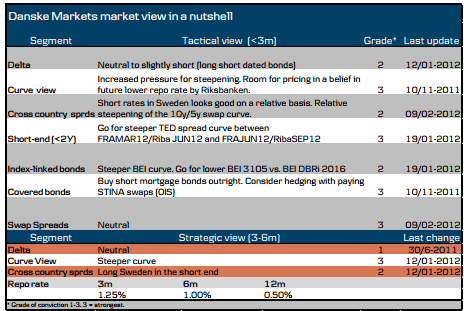 The two top issues on next week’s agenda are of course the Riksbank’s rate
The two top issues on next week’s agenda are of course the Riksbank’s rate
announcement and January CPI data. Expectations of a February cut have lately been scaled back from being almost a fully priced 25bp to slightly above 15bp. In a way this is understandable given that the probable alternatives are zero or 25bp rather than 25bp or 50bp.
However, after the Riksbank’s Company Interview was released Wednesday’s FRA and Riba moved a bit lower again. As we see it, the survey provides a good argument for the RB to lower its 2012 GDP forecast (1.7% calendar adjusted) quite substantially – at least closer to flat. Manufacturers clearly stated that demand from the main market – Europe –deteriorated in Q4 and to an extent that other markets have been unable to compensate for, Companies plan to reduce activity and work forces going forward and Construction and transports have been hit as well. Few expect to be able to raise prices.
We believe that the labour market will be of great importance for the Riksbank scenario this year. In fact, in Q4 we registered the first increase in unemployment in seven quarters, not a big move – only about 7.000 people – but still notable. Judging by the Company Interview we can expect more.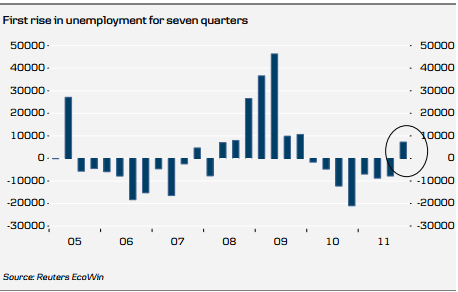 So, we stick to the view that the Riksbank ought to ease.
So, we stick to the view that the Riksbank ought to ease.
Another figure that deserves attention is the January state borrowing requirement that was reported this week. The number came out at 14.6bn, no less than 12.2bn higher than according to the Debt Office’s forecast. Such a big deviation from the forecast is relatively rare and in fact such a big borrowing number in January is rare too looking at the last five years or so. The exception is 2009 during the financial crisis when the DO borrowed 6.1bn. Compared with January 2011, borrowing was 44.5bn higher in January this year.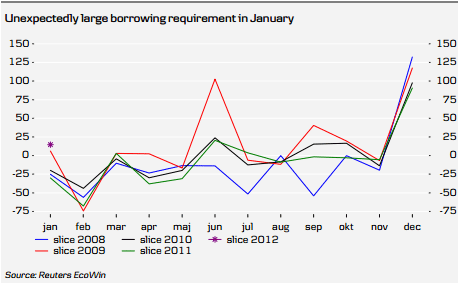
Of course, one should be careful not to make too much out of a single number and the DO offers some partial explanations: Tax rebates and payment of EU fees were about 4bn higher and interest payments around 2bn. But the remaining 6bn (higher than expected outlays in various government agencies) is unaccounted for. This is what we need to monitor, to see if there are signs of weaker business conditions already showing up in government finances through automatic stabilisers. Our projection is that this year’s borrowing requirement will exceed the Debt Office’s current forecast (-25bn) by 25-50bn.
This, in combination with the fact that the DO intends to introduce a new 20-year bond means that a substantial amount of risk will be added to the market this year.
January inflation without any re-weighting effects?
In January the big question is usually how large the impact is on CPI from re-weighting the consumption basket. This year we change from 2009’s pattern to 2010’s ditto. In the table below you find this impact for the past seven years. The past two years’ new information about the composition of the mortgage stock has had a strong impact on the mortgage cost index and this has been shown as a re-weighting effect. This year it appears there won’t be any such effect to speak of. That said, there may still very well be a negative re-weighting effect in other parts of the CPI, perhaps around 0.1-0.2 percentage points as has been the case over the past couple of years.
The past two years’ new information about the composition of the mortgage stock has had a strong impact on the mortgage cost index and this has been shown as a re-weighting effect. This year it appears there won’t be any such effect to speak of. That said, there may still very well be a negative re-weighting effect in other parts of the CPI, perhaps around 0.1-0.2 percentage points as has been the case over the past couple of years.
The table below shows our monthly forecast on a component basis. 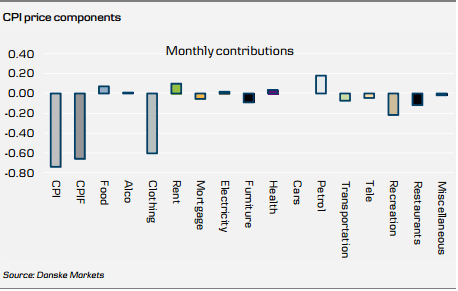 As usual in January, the dominating effect is from clothing sales, pulling down CPI by 0.6 percentage points. Maybe sales have been even larger than we have assumed since clothing sales are still going on by the middle of February. Another factor that may potentially have a significant impact is the VAT cut to 12 % (from 25%) for restaurants. In principle, prices could be cut by about 10%. However, as fast food chains appear to be the only ones that have cut prices, we opt for a much smaller decline of 2%.
As usual in January, the dominating effect is from clothing sales, pulling down CPI by 0.6 percentage points. Maybe sales have been even larger than we have assumed since clothing sales are still going on by the middle of February. Another factor that may potentially have a significant impact is the VAT cut to 12 % (from 25%) for restaurants. In principle, prices could be cut by about 10%. However, as fast food chains appear to be the only ones that have cut prices, we opt for a much smaller decline of 2%.
All in all, this points to CPI and CPIF forecasts for -0.7 % m/m/ 2.4 % y/y and -0.7% m/m/0.9 % y/y respectively.
The Swedish swap curve too flat relative to the EUR curve
In the past few weeks the Riksbank’s expectations have been scaled back, with the market now pricing in around 60bp in cuts in total. Although we understand increasing investor nervousness as we approach the Riksbank meeting, we think the total amount of rate cuts is below what the Swedish economy will need over the course of the year.
Pricing out Riksbank cuts has led to a relative flattening of Swedish yield curves, including the swap curve. This curve movement appears overdone, in our view, unless the Riksbank fails to cut rates next week. We think the latter still seems unlikely, as Swedish data has generally been disappointing. We still expect to get relatively close to a convergence in 3M rates between Sweden and Euroland during H2.
We especially like looking at the 5Y-10Y swap curve box against EUR swaps, which is once again trading near record lows. We find it fundamentally odd that while long rates trade near record lows, only a moderate amount of cuts are priced in at the front of the Swedish curve. Something will have to give. Either the long end will have sell-offs, or the Swedish short end will have to come down relative to euro short rates. Current pricing implies less stress in Sweden in the medium term, but the same amount of pain in the long run.
Interestingly, the relative flattening of the Swedish curve has occurred despite a miserable relative performance in the 10Y SEK-EUR spread. We think that the introduction of the 20Y bond will continue to weigh on the Swedish long end until we are past the auction. Historically, the Swedish market has had difficulties absorbing interest rate risk when it occurs in a short period of time, so the market is probably right to be careful. Wednesday’s weak auction was another sign that appetite for long-dated Swedish bonds is currently low.
Also, as the lending curve to mortgage borrowers is likely to steepen, demand for floating interest rate loans should rise over the course of the year. Even though this should partly be tempered by slowing loan growth, we should still see a significant shift towards floating rate loans as existing fixed rate loans mature. This will mean that mortgage institutions will have to receive significant amounts of swaps, especially in the 3-5Y segment.
Another factor that should give support to the curve box is the relative inflation rate. A more distinct fall in the Swedish inflation rate should translate into steeper curves on a relative basis.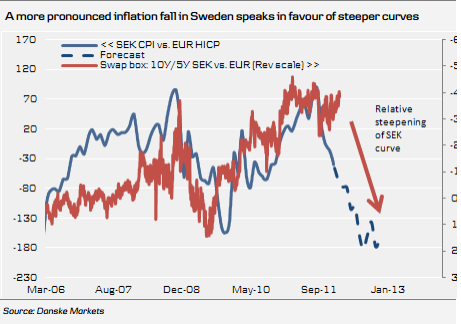 Moreover, over time we would expect the fixing situation in Sweden to improve. Falling Euribor fixings in connection with the ECB’s 3Y repo have led to a downward pressure on 3M Stibor. If we see a large interest in the second 3Y repo that could translate into decreasing fixing spreads in SEK. Falling fixing spreads should affect short-dated swaps the most, leading to a general curve steepening tendency. In EUR, the TED-spread curve (FRA vs forward eonia) is quite flat, whereas it is still significantly inverted in Sweden. A normalisation of fixing spreads would thus tend to steepen the Swedish curve on a relative basis.
Moreover, over time we would expect the fixing situation in Sweden to improve. Falling Euribor fixings in connection with the ECB’s 3Y repo have led to a downward pressure on 3M Stibor. If we see a large interest in the second 3Y repo that could translate into decreasing fixing spreads in SEK. Falling fixing spreads should affect short-dated swaps the most, leading to a general curve steepening tendency. In EUR, the TED-spread curve (FRA vs forward eonia) is quite flat, whereas it is still significantly inverted in Sweden. A normalisation of fixing spreads would thus tend to steepen the Swedish curve on a relative basis. So far the spread has shown some sensitivity to increasing risk appetite, but so far the effect on the curve box has been small. In the longer run, we expect the Riksbank to be a much more important driver for the curve box.
So far the spread has shown some sensitivity to increasing risk appetite, but so far the effect on the curve box has been small. In the longer run, we expect the Riksbank to be a much more important driver for the curve box.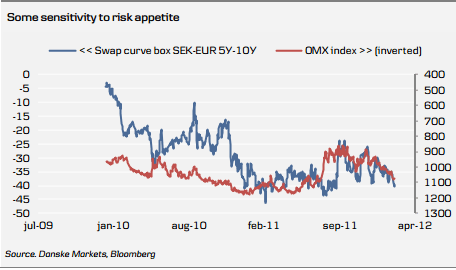 As the Swedish curve is flatter the roll-down effect is slightly negative on the curve box, by around -0.3 bp/month.
As the Swedish curve is flatter the roll-down effect is slightly negative on the curve box, by around -0.3 bp/month.
We set P/L-targets at -15/-55 (star level at -39.5).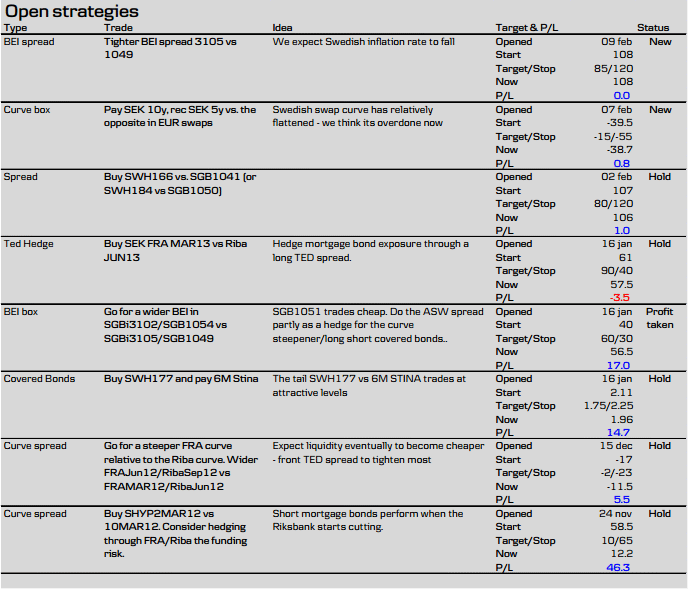

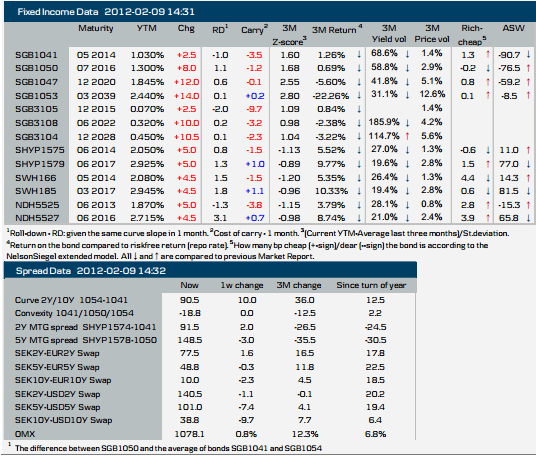
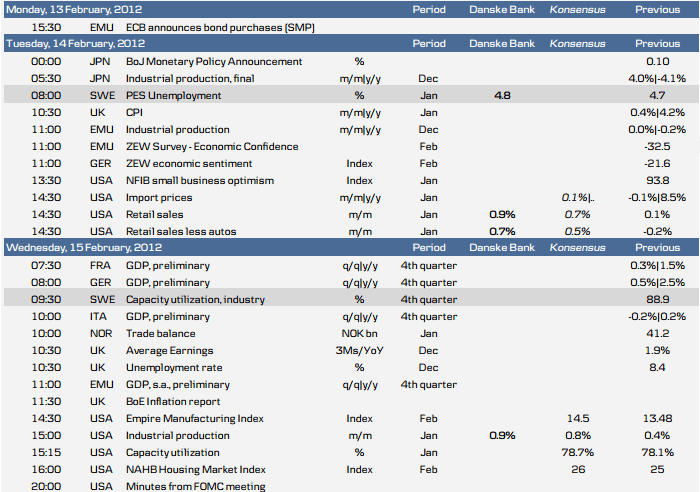
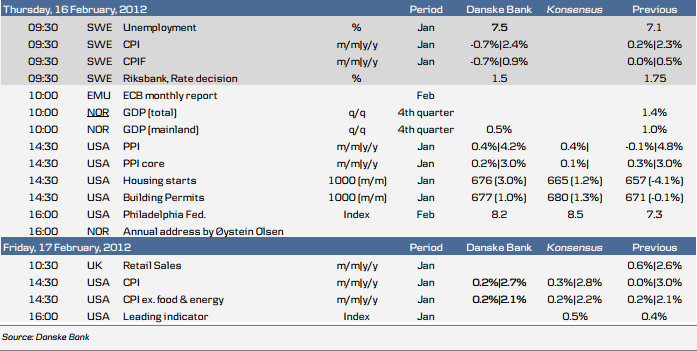
- English (UK)
- English (India)
- English (Canada)
- English (Australia)
- English (South Africa)
- English (Philippines)
- English (Nigeria)
- Deutsch
- Español (España)
- Español (México)
- Français
- Italiano
- Nederlands
- Português (Portugal)
- Polski
- Português (Brasil)
- Русский
- Türkçe
- العربية
- Ελληνικά
- Svenska
- Suomi
- עברית
- 日本語
- 한국어
- 简体中文
- 繁體中文
- Bahasa Indonesia
- Bahasa Melayu
- ไทย
- Tiếng Việt
- हिंदी
Markets Sweden: February 10, 2012
Published 02/11/2012, 09:31 AM
Updated 05/14/2017, 06:45 AM
Markets Sweden: February 10, 2012
Trades
Latest comments
Loading next article…
Install Our App
Risk Disclosure: Trading in financial instruments and/or cryptocurrencies involves high risks including the risk of losing some, or all, of your investment amount, and may not be suitable for all investors. Prices of cryptocurrencies are extremely volatile and may be affected by external factors such as financial, regulatory or political events. Trading on margin increases the financial risks.
Before deciding to trade in financial instrument or cryptocurrencies you should be fully informed of the risks and costs associated with trading the financial markets, carefully consider your investment objectives, level of experience, and risk appetite, and seek professional advice where needed.
Fusion Media would like to remind you that the data contained in this website is not necessarily real-time nor accurate. The data and prices on the website are not necessarily provided by any market or exchange, but may be provided by market makers, and so prices may not be accurate and may differ from the actual price at any given market, meaning prices are indicative and not appropriate for trading purposes. Fusion Media and any provider of the data contained in this website will not accept liability for any loss or damage as a result of your trading, or your reliance on the information contained within this website.
It is prohibited to use, store, reproduce, display, modify, transmit or distribute the data contained in this website without the explicit prior written permission of Fusion Media and/or the data provider. All intellectual property rights are reserved by the providers and/or the exchange providing the data contained in this website.
Fusion Media may be compensated by the advertisers that appear on the website, based on your interaction with the advertisements or advertisers.
Before deciding to trade in financial instrument or cryptocurrencies you should be fully informed of the risks and costs associated with trading the financial markets, carefully consider your investment objectives, level of experience, and risk appetite, and seek professional advice where needed.
Fusion Media would like to remind you that the data contained in this website is not necessarily real-time nor accurate. The data and prices on the website are not necessarily provided by any market or exchange, but may be provided by market makers, and so prices may not be accurate and may differ from the actual price at any given market, meaning prices are indicative and not appropriate for trading purposes. Fusion Media and any provider of the data contained in this website will not accept liability for any loss or damage as a result of your trading, or your reliance on the information contained within this website.
It is prohibited to use, store, reproduce, display, modify, transmit or distribute the data contained in this website without the explicit prior written permission of Fusion Media and/or the data provider. All intellectual property rights are reserved by the providers and/or the exchange providing the data contained in this website.
Fusion Media may be compensated by the advertisers that appear on the website, based on your interaction with the advertisements or advertisers.
© 2007-2025 - Fusion Media Limited. All Rights Reserved.
